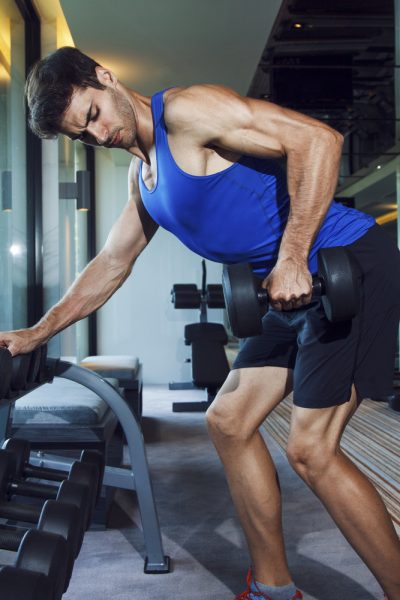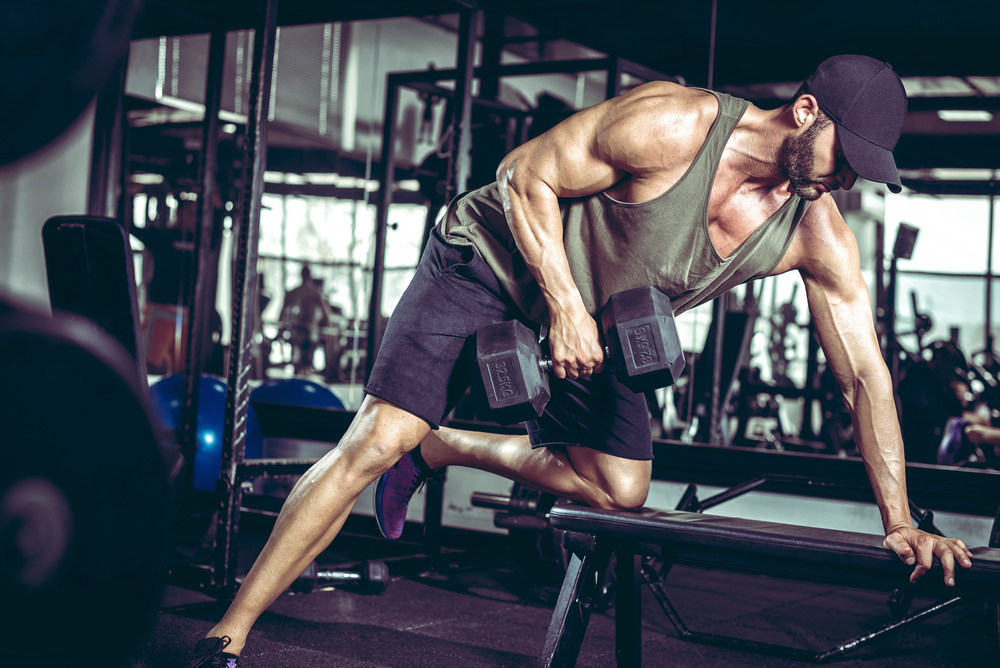If you are looking to build a stronger back, then you should incorporate rows in your exercise program. There are a lot of different types of rows you can utilize, like the bent-over barbell row and the one-arm dumbbell row. Research has shown that when it comes to building stronger back muscles, the one-arm dumbbell row remains one of the best.
Benefits of the arm dumbbell row
These are the benefits you stand to gain if you can perform the movement correctly.
Improved posture
This exercise can aid in the improvement of posture and back strength because it helps in the development of a lot of muscle groups that are responsible for the retraction of your shoulder blades. The dumbbell row is an exercise that should be incorporated by people round forward in deadlifts, sit at a desk, or slouch to help strengthen their backs and improve posture.
Stronger back and grip
Athletes, general fitness practitioners, and lifters all utilize the one-arm dumbbell row as a key exercise for building and strengthening back muscles. You can perform this exercise to achieve muscle hypertrophy and develop back strength in addition to boosting grip and biceps development when you perform it in higher training volumes.
Get Wide and thick
A lot of lifters are fond of dividing their back training from thickening sessions, and use different kinds of techniques to achieve their goal. The one-arm dumbbell is an exercise that gives you the capacity to build both your thickness and width. When you make use of the regular palms-facing-inward grip, you will crush your outer-lat fibers, which is responsible for assisting you to spread your wings. However, this is a movement that involves rowing; you can go for a heavier weight.
Invest in variation
One reason why the one-arm dumbbell row is loved by a lot of people is because of the fact that it is easier for you to change the angle of pull so that you can work different parts of your back musculature. You can fire up the lower lat fiber by pulling the dumbbell toward your hip and also fire the rear delts and upper lats when you pull upwards in a straight line. In addition to that, you can perform this exercise with your palm facing back as it is not only limited to when your palms are facing inward. This engages more of your mid-back muscles as it forces your elbow out.
Remain stable
Throughout the whole workout, your torso will remain stable and supported since you are performing the movement with one hand and one leg on a bench. You are not required to focus on lower back lethargy, body position, or balance, which would allow you to place more effort into achieving the most profound let contractions ever. What this means is that you will experience more rapid growth.
Stretch for size
When compared to the other free weight lat building exercises, the one-arm dumbbell row comes out on top when it comes to providing the biggest stretch at the midpoint of the rep. A significant deal of fiber damage happens when your muscle is stretched intensely against resistance, which would end up sending a very robust anabolic signal to your body. What this results in is greater and faster hypertrophy in the muscle that is being targeted.
Unilateral advantage
The one-arm dumbbell row is a unilateral exercise, and as such, it comes with all the benefits of unilateral movements, which include;
- It to even out all your strength imbalances between the sides of your body.
- It results in muscle fiber recruitment in the targeted muscle
- It allows you to keep your focus and concentration on the targeted muscle.
How to perform the one-arm dumbbell row
For this exercise, you would need either a steady thigh-high area or a bench to rest on to perform the movement. When you have gotten that, place the next tool, which is the dumbbell, down beside the bench. These are the steps to perform the one-arm dumbbell row;
- Place your right leg on the platform, then use your right hand to grip the far end of the bench. Make sure you get the upper part of your body to be parallel to the floor by bending.
- With your left hand, use a grip that is neutral to stretch down and grab the dumbbell. Ensure your back remains straight as you hold the dumbbell with extended arms.
- Next, raise the dumbbell upward toward your chest, you should try to lift with your shoulder and back muscles instead of your arms.
- While lifting, ensure your chest is kept still. Then, squeeze your back and shoulder muscles when you get to the top.
- Then, use a slow and controlled motion to lower the weight until you get your arms fully extended once more. That is one rep.
- Ensure you completed your required number of reps on the right arm, then switch to your other side and do the same number of reps.
Variations of the one-arm dumbbell row
These are the other variations of the one-arm dumbbell row;
Gym ball one-arm dumbbell row
If you want to crank up the amount of work your core has to do to ensure you stay still when performing this exercise, switch out the bench and replace it with an unstable inflatable ball. While you might not be able to lift as much weight as you would when using the bench, the introduction of the gym ball will ensure that the one-arm dumbbell row is a better all-round workout.
Symmetrical stance one-arm dumbbell row
When you have gotten used to the basic version of this exercise, try to take things to the next level by mounting a stance square-on to the platform. Rather than providing support for your body with your hand and leg on the platform, you will only place on hand supporting you and then use the other one to row. What this does is that it levels up the challenge on your core, since you will need to work more to challenge the dumbbell as you ensure your torso remains still when you are rowing upward and downward. These are the steps to follow to perform the symmetrical stance one-arm dumbbell row;
- Stand tall and keep your feet apart by the distance of your shoulder width.
- Lean over on the bench with your right hand by hinging at your hips. Ensure you keep your back straight and push your butt back.
- Row the dumbbell up and make sure it is your arm is only what moves. Do not move your torso when performing the exercise.
Common mistakes when performing the one-arm dumbbell row
These are some of the mistakes people mostly make when performing dumbbell rows in general, and it could impact your form as well as see that you do not reap the maximum benefit of the exercise.
Pinning your shoulder blade
When performing the one-arm dumbbell row, most people often feel the urge to retract their shoulder blade when they get to the top of the move. It is not bad, but when it is pinned at the top all through the whole set, it becomes a problem. When you are performing this exercise, you are meant to feel a slight stretch when you get to the lower end of the movement as your shoulder blades should move around your rib cage. There are problems that can occur when you pin your shoulders in place, such as the downward rotation syndrome. There are only a few situations where you should hold the retracted shoulder position, and that is when it is only needed. Other than that, let your shoulders explore their full movement capabilities.
Too much ROM
When you have too much range of motion when performing the one-arm dumbbell row, it is usually a problem. This is a prevalent issue when doing the dumbbell row as people allow their elbow travel too far past the midpoint of their bodies. When the elbow travels past the midline, it is known as excessive glenohumeral extension, and it could result in anterior humeral glide and excessive scapular anterior tilt, which would leave you with an uncomfortable feeling in your shoulders. What you need to do is bring your elbow toward your back pocket or hips, and you would fix this error. You can also ask your trainer to place their hand off the small of your back so that you know when to stop.
Not pushing away
It is a well-known fact that when you are executing the one-arm dumbbell row, you should place emphasis as well as be conscious of what your moving arm is doing. But, you should also note that your supporting arm, which is the non-moving arm, also plays a crucial role and is as involved in the correct execution of the exercise. Most times, people hang out on their supporting side when doing the one-arm dumbbell row, which would see them “dump” into that shoulder. This would place your scapulae in a dangerous position as it would be anteriorly tilted, and it could cause major harm to your shoulders. To fix this, you to push away or protract on your supporting side, which would provide better stability and positioning, and also give you serratus anterior activation as a bonus.



